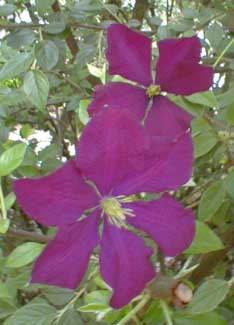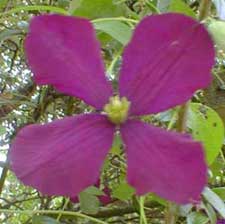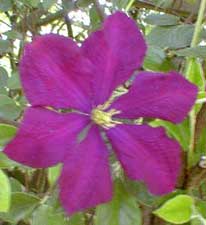
'Etoile Violette' Italian Clematis
"Deep nested in the hill's enormous lap,
With its own ring of walls and grove of trees,
Sits, in deep shelter, our small cottage - nor
Far-off is seen, rose carpeted & hung
With clematis."
-Robert Louis Stevenson
(1850-1894)
(1850-1894)
 'Etoile Violette' ('Violet Star' in French) is a small-flowered clematis of the Viticella group known as Italian Clematis or Italian Leather-flowers. The wild species form has slightly smaller flowers than this cultivar. The species is so hardy that it has escaped cultivation to naturalize in the northeast corner of the Great Lakes region.
'Etoile Violette' ('Violet Star' in French) is a small-flowered clematis of the Viticella group known as Italian Clematis or Italian Leather-flowers. The wild species form has slightly smaller flowers than this cultivar. The species is so hardy that it has escaped cultivation to naturalize in the northeast corner of the Great Lakes region.This cultivar produces gazillions of its three to four inch purple flowers with bright golden stamins. On ours, the flowers have either four petals, or six petals -- it is so interesting that two distinct appearances would occur for blooms on a single plant.
This recipient of the Award of Garden Merit is an heirloom cultivar developed by Francisque Morel of Lyon, France, in 1885.
It can function as a groundcover but is at its best as a climbing vine meandering its way to the top of a largish shrub. When it cohabits with a spring-flowering shrub, then in summer & early autumn, when that shrub is long finished blooming, 'Etoile Violette' will make it look like it is full of clematis blooms. It can also meander its way through a large rose bush & they will be blooming simultaneously.
 Its tendency is to grow to the top of a shrub & bloom primarily in fullest sun, though it requires its roots to be shaded. The semi-woody vines easily reaches ten or twelve feet & can reach fourteen feet or further. Ours climbs to the top of an enormous arbored Franchett's Cotoneaster. It is at the low end of the arbored staircase, while Clematis montana 'Mayleen' winds through the same arbor at the high end of the staircase. 'Mayleen' blooms early in spring, & 'Etoile Violette' blooms in June, so that between them they make the huge cotoneaster look like it is flowering for a very long period.
Its tendency is to grow to the top of a shrub & bloom primarily in fullest sun, though it requires its roots to be shaded. The semi-woody vines easily reaches ten or twelve feet & can reach fourteen feet or further. Ours climbs to the top of an enormous arbored Franchett's Cotoneaster. It is at the low end of the arbored staircase, while Clematis montana 'Mayleen' winds through the same arbor at the high end of the staircase. 'Mayleen' blooms early in spring, & 'Etoile Violette' blooms in June, so that between them they make the huge cotoneaster look like it is flowering for a very long period.It causes no harm to the shrubs it lives with because it is a long airy vine that does not choke out light, & the spent vines are removed each year so there is no accumulation of weight on a shrub.
It will also do mightily fine on a trellis or arbor, but since it has to be cut back each spring, it is not a year-round plant for an arbor, though it's a great addition that cohabits easily with other vines. It can fend for itself handily sharing a trellis with akebia or honeysuckle. Vines that adhere to walls, such as the moonlight vine or climbing hydrangea, can become defacto trellises for one or another clematis which would not on its own attach to an untrellised wall.
Previous year's growth should be pruned down to six inches or foot to start over, as this one blooms only on new growth. This is best done just before spring & before new growth appears, but might also be done late in autumn when it has finished dropping its leaves.
'Etoile Violette' can be propagated from softwood cuttings, but will not grow true from seeds. It is cold-hardy to zone 5 or even 4 with mulching & protection, plus it has sufficient heat-hardiness that it can be grown further south than can most of the larger-flowering clematises.